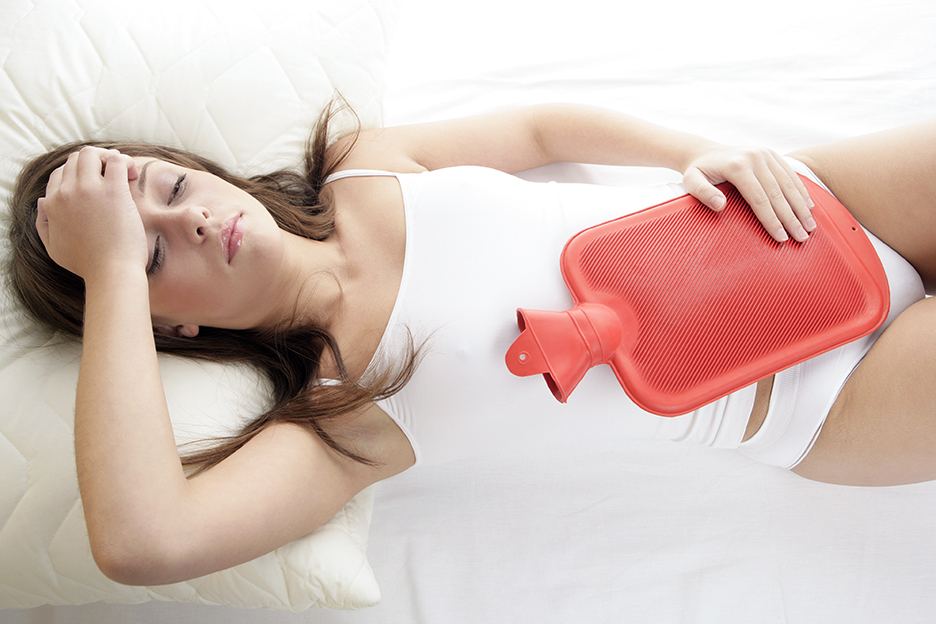For several women, menstruation is a tough time. You’ve surely heard of this expression when a woman nearing her periods is in a bad mood: “She must be having PMS!” But how can this phenomenon be explained?

What is premenstrual syndrome?
Ah, the monthly period… For many women, it is anything but easy. The monthly period can cause them much suffering. Pain, fatigue, and emotional swings may be experienced. When several physical and emotional symptoms are present together before a menstrual period, it can be referred to as premenstrual syndrome, known as PMS for short.
Three in four women have symptoms before and during their menstrual periods. Premenstrual syndrome generally appears a few days before (often two to seven) before the onset of the period and ends when menstruation starts or a few days later. More than 150 symptoms have been identified, the most common being the following:
Physical symptoms:
- headache/migraine;
- fatigue;
- sleeping problems;
- lower abdominal pain or bloating;
- swollen and tender breasts.
Psychological/emotional symptoms:
- mood swings;
- low energy;
- depression;
- anxiety;
- irritability or aggressiveness.
The type, intensity, and duration of symptoms vary considerably from one woman to another. Besides, the exact cause of this problem is unknown. We think that it might be caused by hormonal changes during the menstrual cycle.
It is possible that already existing health problems such as asthma, migraines, allergies, or epilepsy, may be aggravated by the premenstrual syndrome.
How to face the next month?
There are several things you can do to prevent or reduce the intensity of symptoms. All of them are essentially based on a healthy lifestyle:
- Avoid tobacco and alcohol.
- Get a lot of rest and relax during this time of the month.
- Sleep sufficiently.
- Maintain a healthy weight.
- Exercise regularly (30 minutes at least three times a week).
- Eat three balanced meals per day at regular hours (do not skip them).
Good nutrition is essential if you want to ease your premenstrual symptoms. You must cut down on your consumption of salt, chocolate, coffee, or carbonated drinks.
In addition, several studies have shown that the consumption of foods containing calcium help ease premenstrual symptoms. The daily recommended intake of calcium is 1,200 mg for it to have beneficial effects. A glass of milk contains about 300 mg of calcium. Magnesium is also likely to have beneficial effects in reducing menstrual cramps and mood swings. An intake of 300 to 400 mg of magnesium per day is sufficient. Here is a list of foods that contain the highest amounts of the mineral.
|
Foods providing 400 mg of magnesium |
|---|
|
¼ cup of walnuts |
|
¼ cup of All Bran cereal |
|
2/3 cup of tuna |
|
½ cup of cooked spinach |
Available treatments
You should first start with the steps mentioned in the preceding section. Then, if lifestyle changes don’t seem to be enough, medications may be considered.
To reduce menstrual cramps and pain, you can use anti-inflammatory drugs or painkillers, to be taken only when needed. Several of these products are available over the counter and some of them may not be suitable for you, so always ask a pharmacist before buying them.
Taking a hormonal contraceptive, such as the oral contraceptive pill, can contribute to the prevention of the premenstrual syndrome. In some cases, you can consider taking it continuously.
Turning to some antidepressant (against depression) and anxiolytic (against anxiety) medications may be an option for women with emotional symptoms that compromise their daily lives. Some doctors will prescribe them cyclically, that is, for a few days or few weeks before the start of the menstrual periods.
As a specialist, your pharmacist can guide you on the choice of medications, their benefits, side-effects, precautions, and directions for use. Whether you opt for a prescribed or over-the-counter drug, rely on good advice!
For a great many women, getting their periods each month is inevitable, but this doesn’t have to apply to the premenstrual syndrome! It’s time to act. In this way, regardless of the time of the month, you’ll beam like a ray of sunshine and never be a shadow of yourself!